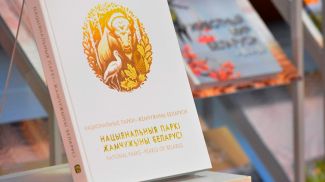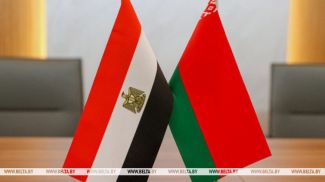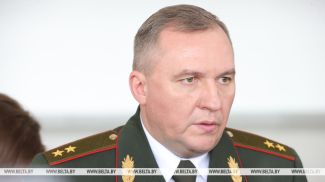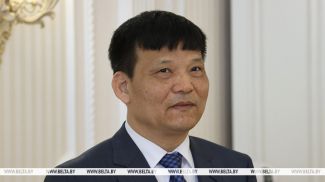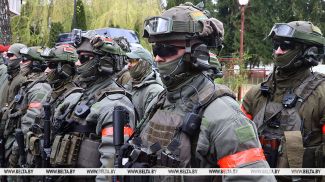Belarus Parliament Elections
The elections to the House of Representatives of Belarus' National Assembly of the sixth convocation were held on 11 September.
A total of 110 members were elected to the new parliament. Of them, 38 are women and 72 are men. The average age of the newly elected members of parliament is 49.7 years.
The voter turnout in the elections to the House of representatives was 74.8% or 5,212,745 voters. The deputies were elected in all 110 constituencies. Thanks to the political and civic activity of voters, the parliamentary elections were held in one round.
Retirement Age Increase
Belarus President Alexander Lukashenko signed Decree No. 137 on the pension system on 11 April. The document aims to improve the pension system in the changing social and demographic conditions. In accordance with the decree, starting from 1 January 2017 the standard pension age will be gradually increased by six months every year until it reaches 63 years for men and 58 years for women. There will be the same increase in the retirement age (by three years during the period of six years) for those entitled to preferential, long-service and military pensions.
A gradual increase in the retirement age will end when the men born in the second half of 1959 and women born in the second half of 1964 retire in the second half of 2022.
Belarus has been working to adjust the pension system to the new realities. A decision to raise the retirement age could not have been postponed any longer. If the country had missed the moment, it would not have been able to increase the retirement age gradually. The share of people of pensionable age in the general population is constantly increasing. It would have been 66 retirees per 100 workers by 2020 and 78 by 2030.
5th Belarusian People's Congress
The 5th Belarusian People's Congress was held in the Palace of Republic in Minsk on 22-23 June. The main areas of the country's development in 2016-2020 were outlined during the forum.
Some 2,500 delegates attended the event. The forum brought together representatives of all sectors of the society: blue-collar and rural workers, representatives of the social and cultural sector and mass media, military, entrepreneurs, students, pensioners. Anyone could call the hotline set up during the Belarusian People's Congress to ask questions or make suggestions. All in all, the hotline received 538 phone calls.
When speaking at the 5th Belarusian People's Congress, Belarus President Alexander Lukashenko said that the program for Belarus' social and economic development in 2016-2020 aims for the future and envisages concrete actions. “This is a program for development, not stagnation. It aims for the future, not the past. And it is a program of action, not expectations,” the President stressed.
The 5th Belarusian People's Congress adopted a resolution which says that that the key goal for the next five years will be to restore and promote the sustainable economic growth as the basis for a successful life of future generations. The national forum demonstrated the cohesiveness of the Belarusian society, peace-loving, multi-vector policy of the state based on the principles of good-neighborliness and cooperation.
Heart-Lung Transplant
On 2 November, Belarusian doctors conducted a complex “heart-lung” transplant surgery for the first time. This surgery is considered in transplantology as the most complicated one. Thanks to the professionalism of the Belarusian doctors, there is now hope for many people to extend the life by not less than 10 years.
The surgery lasted 9 hours. It was led by academician Yuri Ostrovsky who inspired this colossal work in the National Research Center of Cardiology. All in all, the surgery involved about 20 people, including intensivists, coordinators, and doctors who were preparing the recipient for the transplant.
As for the recipient, now he is 33 years old. He was put on the waiting list in March 2016. To conduct a transplant, it was necessary to choose a donor who would match the recipient in many parameters, including height and weight. It took 6 to 7 months to find the donor. A month after the surgery, the patient was discharged from the hospital. His health is assessed as good. Now the young man regularly comes to the National Research Center of Cardiology for follow-up checkups. He gets all necessary medicines free of charge.
There are 15 people on the waiting list for a heart-lung transplant.
Redenomination in Belarus
The new Belarusian banknotes and coins were put into circulation on 1 July 2016. The Belarusian currency was redenominated under Decree No. 450 of 4 November 2015.
The notes of the 2000 design are gradually replaced with notes and coins of the 2009 design at a ratio of 10,000 to 1. The design of the new banknotes and coins is themed around the slogan My Country Belarus. The notes depict Belarus' architectural landmarks, including the Kamenets Tower, the Transfiguration Church, the Rumyantsev-Paskevich Palace, Nesvizh Palace and Mir Castle, the Maslennikov Art Museum, and the National Library.
The redenomination was carried out smoothly thanks to the coordinated work of the retail sector and the banking system. No cases of ungrounded rise of prices were detected, and almost no public complains were submitted.
People's Teacher of Belarus
The title People's Teacher of Belarus has been awarded for the first time under the decree signed by Belarus President Alexander Lukashenko on 24 November. The prestigious title was conferred on Valery Barashkov who teaches physics at Mogilev Oblast State Lyceum No.1.
Many years ago, Valery Barashkov started off as junior research associate at the Mogilev branch of the Institute of Physics of the BSSR Academy of Sciences. However, he decided to make a career change into teaching. Valery Barashkov has been teaching physics for more than 40 years. He worked for 17 years at a secondary school in Osinovka, Chausy District and then moved to Mogilev to teach at Mogilev Oblast State Lyceum No.1.
Valery Barashkov has trained over 200 winners of regional and national physics competitions. His students won nine medals and one letter of commendation at international physics competitions in Norway, Canada, the United Kingdom, Iceland and other countries.
Multiple Launch Rocket System Polonez
The latest product of the Belarusian defense industry — the long-range multiple launch rocket system (MLRS) Polonez — entered into service of the 336th Rocket Artillery Brigade of the Armed Forces of Belarus.
The new product represents a cutting-edge weapon system. Its performance is on par with the best foreign-made rocket artillery systems. Many technical solutions implemented into the new multiple launch rocket system is unique on the world scale.
The most powerful weapon system of the Belarusian army is designed to deliver strikes against enemy personnel in the open and in shelters as well as unarmored and armored fighting vehicles and special vehicles, artillery units, missile systems and air defense missile systems, aircraft at airfields. MRLS Polonez can deliver strikes as far as 50-200km with a high degree of precision. One MRLS Polonez vehicle can deliver precision strikes against eight targets simultaneously, with deviation from specified coordinates staying under 30m.
The first live fire test of the multiple-launch rocket system Polonez took place in Gomel Oblast on 16 June 2016. The tests were carried out by rocket artillery units of the Belarusian army and confirmed the unique parameters of this system as well as its effectiveness and reliability.
Belintersat-1 Satellite Launch
The first Belarusian telecommunication satellite Belintersat-1 was launched into outer space from the Xichang space launch facility, China at 19:57 Minsk time on 15 January 2016. With Belintersat-1 in orbit, Belarus has entered the prestigious list of slightly more than 30 countries that have a communication satellite of their own.
The satellite is the key part of the Belarusian satellite communication and broadcasting system. The satellite is designed to offer the full range of modern satellite communication services in Europe, Africa, and Asia.
The Belintersat-1 satellite was designed and built by China Aerospace Science and Technology Corporation. The satellite's outer dimensions are comparable to those of a car. The satellite weighs over 5.2 tonnes. Its solar battery wings are 22m long when fully deployed. The satellite is designed to work for 15 years.
Storm in July
In July 2016, Belarus was hit by a strong storm. The tempest was so violent that the witnesses called it a ‘tornado'.
The wind uprooted centuries-old trees, moved aircraft at the airport, broke billboards and road signs, and damaged
entire villages. The water filled basements and cars, and the streets of the cities started to resemble Venice's canals.
Almost 12,800 hectares of woodland was destroyed. Berezino, Dzerzhinsk, Minsk, Smolevichi, Cherven and Mozyr districts suffered the biggest blow.
The storm caused power cuts in 638 settlements. Some 200 teams with 220 vehicles participated in the storm recovery effort.
Igor Boki's 6 Gold Medals in Rio
Igor Boki of Belarus topped the list of medalists of the 25th Summer Paralympic Games in Rio de Janeiro by scooping the most of the Games' gold medals.
The 22-year-old champion graced the podium seven times, winning six gold medals and one bronze. Igor Boki won the 100m backstroke, 100m butterfly, 200m medley, 50m, 100m and 400m freestyle events. The Belarusian swimmer set two world and six Paralympic records.
Igor Boki is an 11-time Paralympic champion. At the 2012 Paralympics in London, the Bobruisk-born swimmer made the top of the podium five times and also won one silver. He was named the honorary citizen of Bobruisk after his performance in London.
Igor Boki was presented with a high state award, the Order of Fatherland 3rd Class, to mark his achievements at the 25th Summer Paralympic Games in Rio de Janeiro.
Belarus to Host 2019 European Games
Belarus was elected to host the Second European Games in 2019 after a vote at the 45th General Assembly of the European Olympic Committees (EOC) in Minsk in October.
The high-profile competition will enhance the image and recognizability of the country. The Games will not cost much as the country has the necessary infrastructure: modern sports facilities and hotels meeting the international standards.
Belarus President Alexander Lukashenko said that Belarus is ready to organize the Second European Games in the best way possible. The head of state stressed that the focus will be on the comfort of athletes and fans. “We want athletes to feel comfortable and show their best. We want fans to enjoy the festive atmosphere and the competitions to unite everyone not only in the hosting country but also around the world,” said Alexander Lukashenko. The Belarusian leader added that Belarus will spend about $50 million on the Games.
Champions' Baby Boom
In 2016 two famous Belarusian athletes, Darya Domracheva and Victoria Azarenka, welcomed new additions to their families.
Three-time Olympic champion Darya Domracheva, a wife of Norway's prominent biathlete Ole Einar Bjorndalen, gave birth to daughter Xenia. The baby was born at maternity clinic No.6 in Minsk. Darya Domracheva thanked the medical staff who helped “the miracle happen”.
Darya Domracheva resumed her training four weeks after giving birth. She started training in Belarus' Raubichi and then moved to Sjusjoen, Norway. She and her husband are gearing up for the BMW IBU World Cup Biathlon 4 which is due in Oberhof, Germany on 5-8 January.
Belarus' world number one tennis player Victoria Azarenka gave birth to a baby boy on 20 December. “Today I had my hardest fight and my very best victory! Our son was born healthy and happy! So thankful and blessed! Thank you,” Victoria shared the news on her Instagram page.
The baby's father, Chris Wideman, is a defenseman of NHL's Ottawa Senators.
Victoria Azarenka assured her fans that she was not going to quit tennis. She said that she was inspired by other female athletes who reached even bigger heights in their professional career after giving birth. She added that she would like to do the same. The 2017 US Open will be one of the most important tournaments for her to be back in action.
Belarus' Culture Code
Belarus' first Culture Code was adopted on 25 July. Belarus President Alexander Lukashenko signed the corresponding decree. It is symbolic that the document was approved in 2016 which was declared the Year of Culture in Belarus.
The Culture Code does not have analogues in the post-Soviet space. At the 31st meeting, the CIS Council for Cultural Cooperation agreed to recommend Belarus' Culture Code as a model law for all member states of the CIS.
The work on the document began as early as 2011. The concept was drafted in 2013. The draft document was submitted for public discussion. Thus, experts, and concerned citizens had an opportunity to present their opinion on the document.
The code consists of five sections (The basics of legal regulation in culture”, “Subjects of cultural activities”, “Cultural values”, “Cultural activities”, final provisions) and 257 articles. The document establishing rules in the field of culture is 200 pages long.



